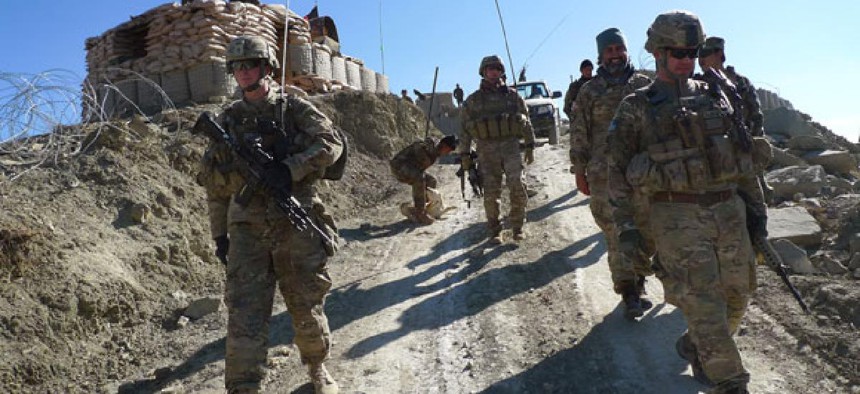
Heidi Vogt/AP
Afghanistan: Eyeing the exits
Neither Obama nor Romney has made clear how fast the remaining force of 68,000 U.S. troops should be pulled out before the deadline.
During the presidential-election campaign the positions of President Obama and presumptive GOP nominee Mitt Romney have converged on the issue of withdrawing most U.S. forces from Afghanistan by the end of 2014. Neither the Obama administration nor the Romney campaign has made clear, however, how fast the remaining force of 68,000 U.S. troops should be pulled out between now and that deadline. With an important milestone approaching next month – when the last of the 30,000 “surge” troops will exit the country – U.S. military commanders are indicating their desire to keep as many of the remaining troops in Afghanistan for as long as possible.
In late May, for instance, Lt. Gen. Curtis Scaparrotti, the second-in-command in Afghanistan, told NPR: “Personally, I would like to stay at 68,000 through the first part of [2013], and then again we’ll make an assessment.” The top commander, Gen. John Allen, told the Senate Armed Services in March, “Sixty-eight thousand is a good going in number, but I owe the president some analysis on that.”
U.S. commanders are angling for maximum force levels because, in their view, the situation in Afghanistan is already reaching its maximum in risk tolerances. “In terms of the mission, the main risk we face is not finishing the work of clearing the Haqqani network from areas in the east that are very close to Kabul,” said Lt. Gen. Dan Allyn, until recently the top U.S. military commander in Afghanistan’s Regional Command East, speaking on Thursday at the Institute for the Study of War in Washington. If the United States keeps the remaining 68,000 troops in-country through next year’s fighting season, it can finish that job, he said. Otherwise U.S. commanders will have to hand the burden to Afghan Security Forces that are still struggling to stand on their own. “That’s not an insignificant risk,” he said.
If history is any judge, however, the generals may not get their wish for a pause in troop withdrawals. The White House is reportedly considering a plan backed by National Security Adviser Thomas Donilon to pull 10,000 more troops out by the end of December, for instance, and then 10,000 to 20,000 more by next June.
“I’m very concerned, because the track record of our generals getting their way on troop levels is not good,” said retired Gen. John “Jack” Keane, the former vice chief of staff of the Army and an architect of the Iraq surge, also speaking at the Institute for the Study of War. The last U.S. commander in Iraq wanted to maintain a residual force of roughly 20,000 troops, he noted, and got zero. U.S. commanders likewise requested an Afghan surge of 40,000 to 60,000 troops, and had to settle for 30,000. U.S. commanders wanted those surge forces to remain in Afghanistan through 2013, a request that was also rejected when the September 2012 deadline was set for their withdrawal. “So I hope General John wins the argument about keeping the current level of forces in place, but if he does, it will be the first time one of our generals won an argument on force levels,” Keane said. “I think the national-security team will do what they can to reduce the number.”
Talk of an accelerated withdrawal comes even as some NATO planners are proposing that the Afghan Security Forces be reduced from 352,000 to 230,000 after 2015, as a way to save $2 billion a year in international funding. “So now we are talking about pulling 100,000 NATO troops out of Afghanistan and shrinking Afghan forces by 100,000 plus, even as we leave in place these sanctuaries for Taliban insurgents inside Pakistan,” Keane said. “I think that will bring the Afghan mission to the brink of failure.”







